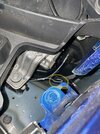I'm using a Icego 20L off amazon.
As others mentioned concerns about the 12v -- from what I understood, the inverter should assist the 12v as needed. Should I be worried about the battery being drained at 30w peak // maybe 10w average over the hour? If it does drain, I assume the inverter should charge it.
I guess there's two questions:
(1) Will the lead battery die from a phantom load such as what i'm describing? Or will the inverter see the voltage drop and just charge it.
(2) Will such a load shorten the life of a lead battery down to something dramatic, like 2 months vs 2 years. If so, maybe a lithium 12v will be fine with the load.
I have a 700Wh battery bank -- it's just so nice and cost such a pretty penny, I'd hate to just throw it into the car to bake in the sun. The car can get 100 degrees, maybe 120. This power bank is a LiFePO4 battery -- so im not sure if the heat will kill it before the charging does. From what I've read, these power banks -- heat is the worst thing for them.
That being said, I wonder what the diff is between a power bank getting hot and dying prematurely, and a lithium 12v in the frunk. I'd imagine they both get hot. Maybe my powerbank worries are mute.
To answer to the question (1) I suspect that the DC/DC Converter will be running higher than usual and you might get a failure alert requesting to get a new 12 V battery.
And getting a new battery would have any effect to solve this issue.
And for the question (2) as you mentioned it, a 12 V battery should not be discharged below 50% of its capacity. This is why refrigerators running on batteries in a boat or a bus
have an interface to control the battery status whose function is to stop the refrigerator if the battery is discharged and to let the refrigerator to restart only when the battery is charged.
Using a 12 V lithium battery seems to be an expensive solution, well you are right you could reach may be 10% of the capacity, or you could double the size of the original battery.
But how often are you using your refrigerator? It would be different if you have a Patrol car with a lot of radio equipments.
I would not recommend playing too much with the 12 V battery as it is a weak point on any electric car. You could run a tire pressure pump for a little bit
but running a refrigerator all the day long might create problems.
It is why having a separate motorcycle battery, that could be charged at night when you are at home could be simple. Or using an isolator to charge the secondary battery,
but avoiding to drain the primary battery.
As you mentioned it, I noticed that you are using an
Iceco 20L Refrigerator. I try finding some information about the compressor used for this portable fridge.
It seems to be made by
Danfos, it is a
DC Compressor (
Model BD Micro BD1.4F) and you are correct about the power of 30 W to 50 W.
I found an Amazon comment of a user, using a Wattmeter, reporting a daily consumption of about 700 Wh or about 30 Wh.
In fact, I am a little bit puzzle because I would assume that a refrigerator is only running about five minutes and stop for ten minutes, or run about one third of the time?
I noticed that you already use a battery pack
BLUETTI Power Station EB70 700W, so does this battery pack is sufficient for your daily need?
Note: You mentioned the high temperature inside the car in middle of the day when parked. I wonder if you have any tinted windows, glass roof sunshade, or windshield sunshade?
To provide a better sun protection, I also cover the outside of the front windshield and half of the roof, and also the rear window and half of the roof with two large
external sunshade covers.
These provide an additional insulation avoiding the sun baking the car canopy.



